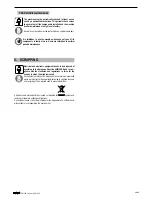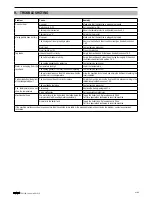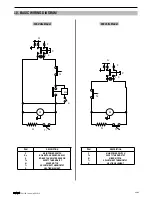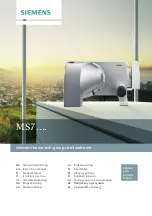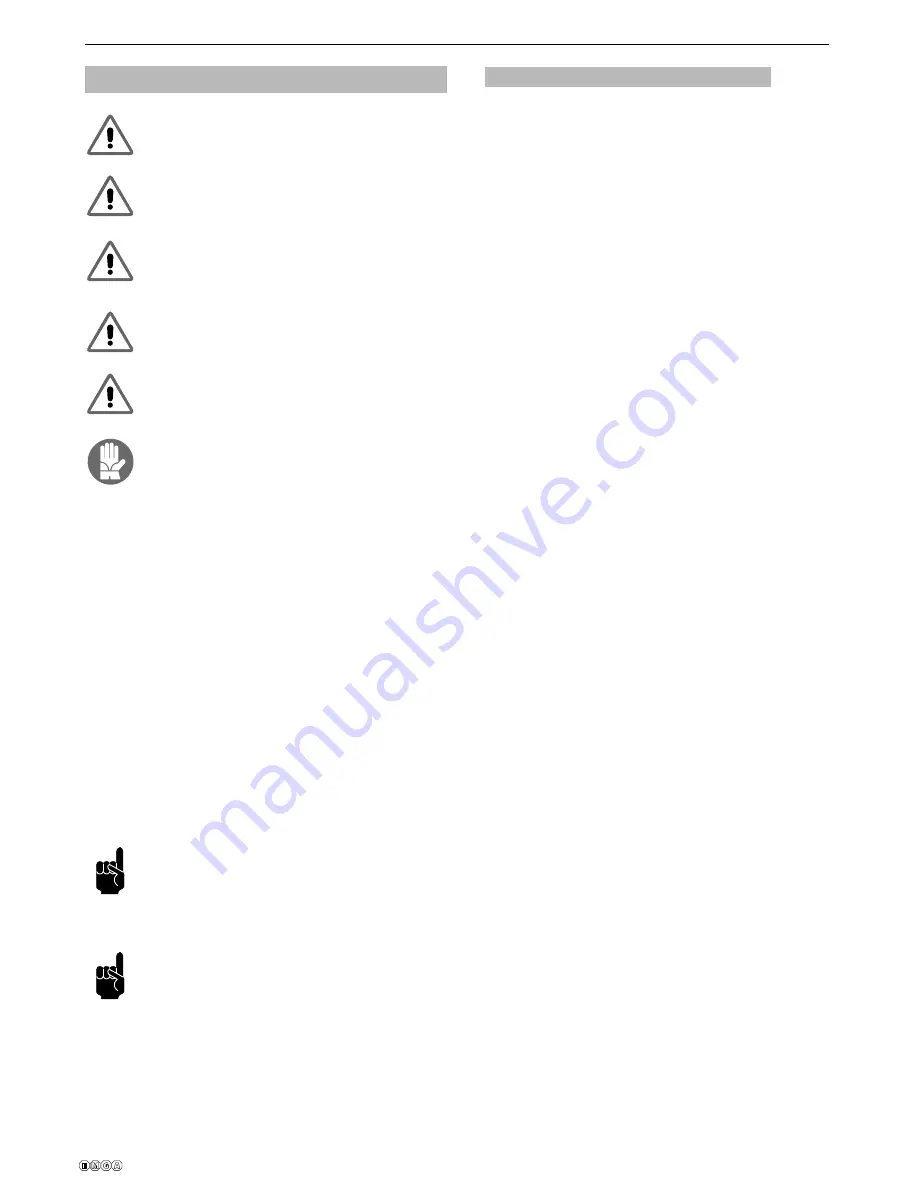
561105-10 en ma 2012.10
10/22
7. CLEANING AND MAINTENANCE
Machine cleaning and maintenance must be performed with the
main switch set to -OFF- and the machine unplugged from the
mains electricity.
Warning: each time that the bowl is filled with any type of prod-
uct (food or sanitising product), make sure that the mixing rod
is present.
Warning: before carrying out any cleaning job wait until the ma-
chine has cooled down sufficiently.
Warning: the use of abrasive and/or metal sponges to clean the
machine or its components is completely prohibited; only use a
damp cloth and/or non-abrasive sponge for cleaning.
Warning: only use the cleaning brush provided to clean the
channel connecting between the tank and the tap (see section
7.5, figure 25); never use this brush to clean other parts.
Before performing any cleaning and maintenance operation on
the machine, wear the personal protections (gloves, glasses,
etc.), which are recommended by the safety standards in force
in the country where the machine is used.
When performing the Cleaning and Maintenance operations, follow these in-
structions:
• wear protection accident-proof gloves;
• do not use solvents or infl ammable materials;
• do not use abrasive and/or metal sponges to clean the machine and its com-
ponents;
• take care to avoid dispersing liquids in the surrounding area;
• do not wash machine components in a dishwasher;
• do not dry parts of the machine in a conventional and/or microwave oven;
• do not immerse the machine in water;
• do not expose the machine to direct sprays of water;
• clean only with warm water and a sanitising product made from sodium
hypochlorite diluted in water to obtain an active chloride concentration of
0.02%;
• on completing work, make sure that all protective covers and guards that
have been removed or opened are set back in place and properly secured.
Cleaning and sanitization are operations that must be performed with utmost
care and on a regular basis to guarantee the quality of the beverages dispensed
and compliance with mandatory hygiene standards.
Each bowl must be cleaned and sanitized for a product change
at least every 2 days and in any case in compliance with the
current hygiene regulations in the user’s country. These opera-
tions must be made more frequently if demanded by the char-
acteristics of the product used; for further details, contact the
product supplier.
The metal, plastic and rubber materials used to make these
parts, combined with their specific shapes make cleaning easi-
er but do not prevent the formation of bacteria and mould in the
event of insufficient cleaning.
7.1. Cleaning and sanitation procedures
When performing cleaning and sanitation operations, proceed as described
here below:
• empty the product from the bowl,
(see paragraph 7.2);
• remove the bowl from the machine,
(see paragraph 7.3);
• remove the tap from the machine,
(see paragraph 7.4);
• clean the pan,
(see paragraph 7.5);
• disassemble the tap previously removed from the machine,
(see paragraph 7.6);
• wash and sanitise the machine’s component parts,
(see paragraph 7.7);
• refit the bowl on the machine,
(see paragraph 7.8.1);
• use a damp cloth and/or non-abrasive sponge soaked in sanitising pro-
duct to clean the tap coupling;
• re-assemble the tap,
(see paragraph 7.8.2);
• fit the tap onto the machine,
(see paragraph 7.8.3);
• perform the sanitising procedure for the inside of the machine,
(see paragraph 7.9);
• clean the drip tray,
(see paragraph 7.10);
• clean the bowl lid using a damp cloth and/or a non-abrasive sponge,
(see paragraph 7.11).
• empty out the boiler tank,
(see paragraph 7.12);
• clean and de-scale the boiler tank,
(see paragraph 7.13);




















